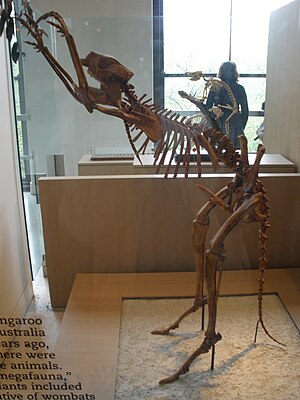Short-snouted kangaroos
| Short-snouted kangaroos | ||||||||||||
|---|---|---|---|---|---|---|---|---|---|---|---|---|

Skeleton of the short- snouted kangaroo Simosthenurus |
||||||||||||
| Temporal occurrence | ||||||||||||
| Miocene to late Pleistocene | ||||||||||||
| Locations | ||||||||||||
| Systematics | ||||||||||||
|
||||||||||||
| Scientific name | ||||||||||||
| Sthenurinae | ||||||||||||
| Glauert , 1926 | ||||||||||||
The short- snouted kangaroos (Sthenurinae) are an extinct subfamily of the kangaroos . The animals were represented by several genera in Australia until the late Pleistocene . Among their ranks was Procoptodon , the largest known kangaroo of all time. For a long time it was unclear whether the banded rabbit kangaroo ( Lagostrophus fasciatus ) still alive belongs to the short- snouted kangaroos . In that case it would have been the last representative of the family. In the meantime, however, the species is placed in a separate subfamily (Lagostrophinae) together with the genus Troposodon, which died out in the Late Pistocene . In November 2018 published DNA comparisons, however, show that the banded rabbit kangaroo is the closest relative of the short-snouted kangaroo among all kangaroos living today.
features
Many short-snouted kangaroos had extremely shortened snouts compared to today's kangaroos. Procoptodon and Simosthenurus in particular are distinguished by this. The species Hadronomas puckridgi is known from the Miocene and seems to be at the base of the Sthenurinae evolution. Within the family, Sthenurus is likely to be a primitive sister group of the Simosthenurus - Procoptodon line.
In contrast to all recent kangaroos, which are sole walkers , move quickly by jumps and slowly walk on all fours ( quadruped ), using their tail as the "fifth leg", the short-snouted kangaroos are said to have walked on their hind legs as tiptoe . The front legs and tail were too weak to support the body weight during the quadruple, slow locomotion, the lumbar spine was not flexible enough.
Genera
- Archaeosimos (late Miocene)
- Hadronomas (late Miocene)
- Metasthenurus (until late Pleistocene)
- Procoptodon (until late Pleistocene)
- Simosthenurus (until late Pleistocene)
- Sthenurus (until late Pleistocene)
Individual evidence
- ^ A b J. Long, M. Archer, T. Flannery, SJ Hand: Prehistoric Mammals of Australia and New Guinea: One Hundred Million Years of Evolution. University of New South Wales, Kensington 2002, ISBN 0-8018-7223-5 , pp. 161-162.
- ↑ GJ Prideaux, NM Warburton: An osteology-based appraisal of the phylogeny and evolution of kangaroos and wallabies (Macropodidae: Marsupialia). In: Zoological Journal of the Linnean Society. Volume 159, No. 4, 2010, pp. 954-987. doi: 10.1111 / j.1096-3642.2009.00607.x
- ↑ Manuela Cascini, Kieren J Mitchell, Alan Cooper, Matthew J Phillips: Reconstructing the Evolution of Giant Extinct Kangaroos: Comparing the Utility of DNA, Morphology, and Total Evidence. In: Systematic Biology. 2018. doi: 10.1093 / sysbio / syy080
- ↑ CM Janis, K. Buttrill, B. Figueirido: Locomotion in Extinct Giant Kangaroos: Were Sthenurines Hop-Less Monsters? In: PLoS ONE . 2014. doi: 10.1371 / journal.pone.0109888
literature
- Gavin Prideaux: Systematics and Evolution of the Sthenurine Kangaroos . (= University of California publications in geological sciences. Volume 146). Univ. of California Press, Berkeley et al. 2004, ISBN 0-520-09845-5 .
